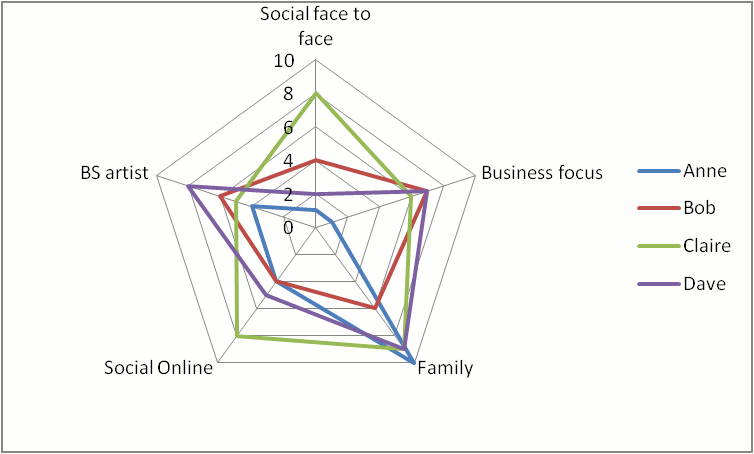This post is a response to the thought provoking post that Raj Sundarason posted on SCN – Identifying the Real Value of ME
In that post Raj talks about how:
“We need to embrace the concept of the “IDENTITY of ME.
Step 1: We need to recognize the different elements of My Identity (ME)
Step 2: To scale and be successful we must find a way to tap into the value of ME
Step 3: The Complete ME requires an integrated enabling infrastructure”
That grab of the bullet points of his post does not do it justice – go and read it yourself! But it will work as a nice framework for my response.
Recognising the social or not ME
I would suggest that the layers that make up an individual are very varied. In the same way that we see ridiculous personality profiling:

We can generate similar breakdowns on the factors of their identity:

You should note that these graphs were generated using random numbers in a spreadsheet, and mean absolutely nothing! But I bet you could recognise some people you knew looking at the data there if you looked. And here is where we have to be very, very careful. We take into any discussion about what makes up identity some very strong views of what defines identity is that are heavily influenced by the people that we surround ourselves with. A person who spends much of their time online (like myself) will naturally be more inclined to think about the online social interactions that take place. A person who is never online (yes, there are a few of those left) is more likely to think about person to person interaction. Even what makes up an identity is very much up for debate, is your community credibility part of your identity? (probably) or is it a result of the social and professional contributions? (probably). Whilst the 5 big personality traits are pretty well agreed (although putting them in a radar graph is a complete abuse) the points that make up an employee’s identity aren’t quite so well understood (as far as I know. There are probably hundreds of PhDs in sociology which discuss that and they probably even have some sort or acronym that is universally accepted to represent the different factors… But I don’t know about it so we’ll just assume that it doesn’t exist for the sake of a good story 😉 )
So to my point here. When we consider leveraging the power of an employee’s identity we need to consider that for different people this will need to be achieved in different ways. Whilst I think and agree that in many situations the general result is the same, if a strategy only addresses one aspect of an employee’s identity then the end result will vary wildly in the same way that identities are made up in wildly different ways.
Getting to the value of identity
So how do we actually use identity to give our business value? Well firstly I think we need to consider what we would loose if we do not recognise the value that an employee brings that is above and beyond their mandated position description. Perhaps this is what people talk about when they blather on about “cloud DNA” and how worried they are that Lars is leaving SAP. Personally I think that’s tummy-rot and one person will rarely have such an impact, no matter how strong their identity. But it does give a nice example of how we need to value and assign value to our employees by thinking about their identity in the wider sense.
So the next question must be, if we can see value in identity, how can we grow that value? To answer that question with another, does all identity growth equal value? Certainly in some areas, but not in others. If your employee is a passionate political advocate, they may well be growing their identity but also at some point you may find that the passion/identity conflicts with your business growth. I’ll use myself as an example. I’m quite passionate about environmental issues, I fear for the legacy we are leaving our children in the way that our planet is being abused. It’s quite possible that this will conflict with potential work that my company might partake in.
Identity has value, but it also has risks, leveraging one and recognising the other will take skill. Which brings me nicely to the final point.
Integrated analysis environment
I agree with Raj that by figuring out which parts of an employee’s identity can be leveraged towards business growth a company has the opportunity to create great wins. An employee who feels that their whole identity is supported by the company is going to be far more loyal and likely to produce results/recommendations/inspire others than one who feels that their company just doesn’t understand them.
To this point companies will need to be very careful in attempting to leverage the identities of their employees. Again I will use myself as an example: If my company asked me to start tweeting references to a new solution that we were marketing I would be very resentful. Why? Just read my thoughts on anti-social social media. I would move camp very quickly from feeling that my company was supporting me and was aware of what I was doing that was helpful to a view of “you just don’t understand!”
It’s like the return to work legislation here in Australia, you don’t encourage your employees to return to work, you support them. In the RTW situation it’s due to legal nuances that can stop you getting fined millions of dollars, but in general terms if you can support your employees to leverage their identity for your business cause, rather than putting any pressure (intended or not) then you’re on a winner. Supported employees are less likely to feel that you misunderstand them and more likely to join in (even if it’s not something they would have done without the support.)
But before you can offer support, you’d better understand where your people are and what they do and what makes up that diverse mix of identity in your population of employees. Thus the need for, rather than infrastructure to enable, infrastructure to analyse. Helping your people to be great online bloggers for your company makes no sense if your people aren’t interested in being near a computer once they leave the office. Likewise, targeting your employees to help recruitment at the next trade conference they attend is pointless if they will be avoiding any social contact whilst they are there.
In the race to use the connectedness and influence of our employees towards the good of the company, the first companies that are able to effectively analyse where their employees are at will have a huge advantage. I agree with Raj that we must also measure the effectiveness and dollar returns of the methods and processes that are put in place to leverage the identities, but this is pointless without understanding the base that we are manipulating supporting.
To the end of analysing the identity make up of your employees, we are entering a phase where social network analysis is a real possibility within a company. Whether this analysis is through scanning email conversations for semantic meaning and the senders, recipients and cc’s used as nodes in an influence map. Or it’s through direct analysis of outside-of-enterprise relations with employees encouraged supported to upload their contact lists into gamified social referal solutions. The challenges with privacy will be the first obvious hurdle, but if Facebook has over a billion users then there are at least a few people who don’t care that much… Look out for the social media disclosure statement in your next employment contract, and I’ll bet your employer will be doing a lot more with your details than just monitoring your Klout score!
Summary to a long winded ramble that could have been composed in a pub on a Friday evening (but wasn’t)
Raj, I hope I added some value/response to your post! In summary, yes I agree, leverage the identities of your employees to a) build a better workplace for them and b) return better result for your company. And yes, I think that companies that will be able to do this will have a huge advantage. But I think the first and more important step is to start understanding who your people are outside of their current work personas. Understand the identities that you actually have, and once you have that information you will be in a better place to start thinking about how or even if you can use that information.


